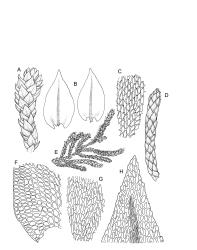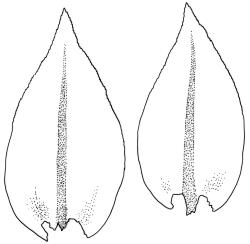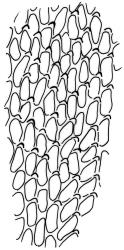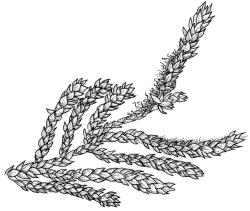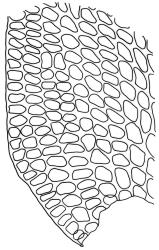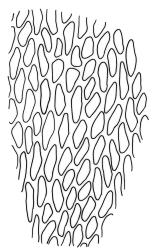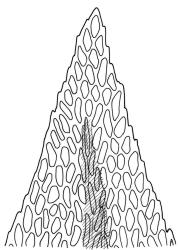- ≡ Leskea imbricata Hook.f. & Wilson in Wilson, Bot. Antarct. Voy. III. (Fl. Tasman.) Part II, 202 (1859)
- ≡ Pseudoleskeopsis imbricata (Hook.f. & Wilson) Thér., Ann. Cryptog. Exot. 2: 20 (1929)
Plants small and slender, forming loose or dense, dull, olive-green, golden, or red-brown mats. Stems creeping, subpinnately branched, the branches distinctly curved. Shoots terete and often broadened near their apices. Stem and branch leaves crowded, erect and imbricate when dry, spreading when moist, broadly ovate and acute or obtuse, 0.5–0.75 × 0.25–0.4 mm, obscurely twice plicate, weakly decurrent, weakly serrulate above, weakly recurved below; mid laminal cells short-rhomboid, obscurely bulging at upper ends (prorate), mostly c. 15–18 × 3–5 µm; cells at basal margins oblate in several rows that may extend ¼ or more up the leaf. Costa stout, ending below the leaf apex, toothed abaxially above. Paraphyllia absent. Propagula (branchlets) absent.
Autoicous. Perichaetia scattered on stem, c. 2 mm; perichaetial leaves oblong-lanceolate, costate, 1.5–2 mm long, with cells irregularly elongate. Perigonia gemmiform, scattered on stems, the leaves broadly ovate and ecostate. Setae 8–14 mm, flexuose; capsules erect or weakly inclined, oblong-cylindric and curved, narrowed at the mouth when dry, c. 2 mm; annulus apparently absent; operculum conic, blunt. Peristome double, inserted close to mouth, ± hypnoid; exostome teeth lanceolate, yellow-brown, c. 380 µm long, cross-striolate in bottom half or more, bordered, with numerous trabeculae on inner surface; endostome with a nearly smooth (and sometimes irregularly perforate) basal membrane, segments lanceolate, nearly equal the teeth, usually perforate, baculate distally; cilia lacking. Calyptra naked, presumably cucullate. Spores mostly 14–18 µm, papillose.
Brotherus 1925, fig. 655; Scott & Stone 1976, pl. 78.
Confusion is most likely with Hedwigidium integrifolia, but P. imbricata is a more delicate and more elegant plant with the "combed-out neatness" mentioned above. The leaves here are also much smaller (up to c. 0.75 mm vs mostly 1.4–1.8 mm), obviously costate, and with laminal cells obscurely prorate as opposed to the ecostate leaves with sinuose and densely pluripapillose laminal cells in the Hedwigidium. Pseudoleskea imbricata occurs primarily on limestone, a substrate avoided by H. integrifolium.
When thoroughly dry and dark red-brown in colour, Pseudoleskea imbricata can resemble species of Andreaea, but no species of the latter genus occur on limestone. In the presence of capsules, such confusion would not be possible.
NI: N Auckland including offshore islands (HC), S Auckland (Taupō), Hawke’s Bay (Tāhaenui Valley, Māhia Peninsula, Taradale), Wellington (Ōwāhanga River); SI: Nelson (Golden Bay, Woodpecker Bay, Punakaikī), Marlborough (Spray Point, Marble Point), Canterbury (Lowry Peaks Range, Mt Grey, Waipara, Peel Forest Village, Raincliff, Pareora River), Otago (numerous localities); Ch.
Australasian. Mainland Australia (Qld*, N.S.W.*, A.C.T.*), Norfolk I. Reported from South Australia and Victoria by Scott & Stone (1976). They, together with Dalton et al. (1991) and Streimann & Klazenga (2002), have all doubted its occurrence in Tasmania. This is despite its Mt Wellington type locality, from whence the protologue (published in 1859) states it was collected by Oldfield. Images of type material of Leskea imbricata are not available on JSTOR (accessed 8 November 2017). Lyn Cave (pers. comm., 23 April 2018) informs me that there is a single Tasmanian collection in HO: a 1999 specimen collected from limestone in the vicinity of Mole Creek.
Mainly on limestone, in both coastal and inland sites and often in highly insolated situations. One J.T. Linzey collection from Buckland’s Crossing (Otago L.D.) is purportedly from "damp sheltered schist by stream side". B.H. Macmillan has collections from the "base of Cordyline australis trunk under [a] limestone bluff" at the Pareora River. Fruiting material from Peel Forest Village grew on a small stone (basalt) bridge and the plants grew on the basalt rather than the mortar, although some influence of the mortar could not be excluded. It is commonly collected in Otago L.D., but there are few records from the North I. Fruit is surprisingly rare (and usually sparse) given that this species is clearly autoicous; all the fruiting specimens seen are from Otago or Canterbury L.D. Often associated with Tortula and Syntrichia spp., Leptodon smithii, and Thuidiopsis spp., incl. T. sparsum. Ranging from sea level to c. 400 m (Lowry Peaks Range) on the South I.
Scott & Stone’s (1976, p. 407) description of the branches is apt and worth quoting here. The branches are "parallel and almost unbranched so that mats of shoots have an elegant, combed-out neatness which they share with almost no other moss. This effect is enhanced when dry by the leaves which are tightly overlapping and closely pressed to the stem, giving a very smooth julaceous shoot."
The decurrent leaf bases remain attached to the branches when the leaves are removed, and they are often suggestive of paraphyllia under the microscope. While paraphyllia are often present in other species of Pseudoleskea, they are absent in P. imbricata.
The short-rhomboid (and often somewhat irregular) mid laminal cells and its autoicous sexuality make this species anomalous in the genus Pseudoleskea, and these features could be used to argue for placement in the predominantly Asian genus Pseudoleskeopsis Broth., as was proposed by Thériot (1929, not seen). However, little material of Pseudoleskeopsis has been available for comparison. Also, Brotherus’s (1925, p. 307) concept of Pseudoleskeopsis is based, in part, on well-developed endostomal cilia, and our species lacks cilia. The decision on the generic affinities of Pseudoleskea imbricata is best made in a monographic context. I consider it advantageous to agree with Sainsbury (1955) and Scott & Stone (1976) until such time as the generic limits in the Leskeaceae can be thoroughly evaluated.
The name Pseudoleskea calochlora was applied to some N.Z. material by Brotherus. This name is a nom. nud. coined by Brotherus & Watts and apparently based on N.S.W. material.




